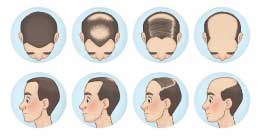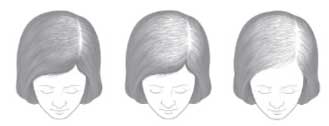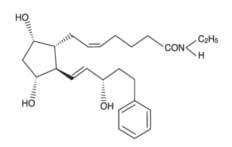Bimatoprost and Hair Loss
Bimatoprost and Hair Loss
What is Male Pattern Hair Loss?

Male pattern hair loss (MPHL) or androgenetic alopecia is the gradual loss of hair which begins after puberty. It is most commonly seen as a receding hairline affecting the top and front of the head. It is a physiological phenomenon that can impact the quality of life of individuals. MPHL occurs for a number of reasons such as decreasing androgen levels with aging which causes various hormone changes contributing to hair loss.
Is MPHL inherited?
MPHL also has a strong genetic predisposition where individuals can inherit sensitivity to the effects of dihydrotestosterone (DHT) which is believed to shorten the anagen phase. The anagen phase is the growth phase of the hair cycle which usually lasts 2-6 years with about 90% of hair follicles in the anagen phase at any given time. The shorter this phase is, the fewer and finer the hairs grow; with decreased DHT, this phase can be as short as weeks.
How common is MPHL?
MPHL is largely inherited as stated above and also has genetic components. Different races are affected at various times and with a range of severity. Up to 50% of Caucasians will experience some degree of hair loss by age 50, 80% by the age of 70. These numbers affect Japanese and Chinese men less and African American men more.
What is Female Pattern Hair Loss?

Female Pattern Hair Loss (FPHL) or alopecia is similar to MPHL regarding the mechanism of occurrence. FPHL affects one-third of women and among postmenopausal women, two-thirds of women experience FPHL. FPHL most often presents as hair thinning or bald spots which can severely affect emotional well-being in those who suffer from it.
What is bimatoprost?

Bimatoprost is a prostaglandin F2-α agent which is currently FDA indicated for the treatment of elevated intraocular pressure and hypotrichosis of the eyelashes. The success of bimatoprost in treating hypotrichosis of the eyelashes, which is when there is an inadequate amount of eyelashes, has led to investigating its use in other types of hair loss.
How does bimatoprost work?
Bimatoprost works to increase the percent and duration of hairs in the anagen phase which leads to increasing eyelash growth, length, thickness, and darkness. In clinical trials, bimatoprost has been reported to stimulate blood flow to hair follicles, inducing hair growth. Bimatoprost also increased production of molecules in the dermal papilla which helps to activate the transition from the telogen to the anagen phase and to increase the duration of the anagen phase leading to hair growth.
What are the possible side effects?
The most frequently (<4%) reported adverse reactions include:
- Eye pruritis
- Conjunctival hyperemia
- Skin hyperpigmentation
- Ocular irritation
- Dry eye symptoms
- Periorbital erythema
How to obtain bimatoprost?
CareFirst Specialty Pharmacy can work with your doctor to find the best formulation for your condition and lifestyle. We are able to compound bimatoprost in a variety of ways such as a foam or a solution as well as add other ingredients to the formulation. Contact a compounding pharmacist today with any questions.
References:
- Yevher Lorena Barrón-Hernández & Antonella Tosti (2017) Bimatoprost for the treatment of eyelash, eyebrow and scalp alopecia, Expert Opinion on Investigational Drugs, 26:4, 515-522, DOI: 10.1080/13543784.2017.1303480
- Khidhir, K.G., Woodward, D.F., Farjo, N.P., Farjo, B.K., Tang, E.S., Wang, J.W., Picksley, S.M. and Randall, V.A. (2013), The prostamide‐related glaucoma therapy, bimatoprost, offers a novel approach for treating scalp alopecias. The FASEB Journal, 27: 557-567.
- https://www.health.harvard.edu/staying-healthy/treating-female-pattern-hair-loss
- https://media.allergan.com/actavis/actavis/media/allergan-pdf-documents/product-prescribing/20170829-LATISSE-USPI-72303US17.pdf




Comments